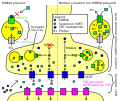File:Main mechanisms of action of MDMA in humans.svg
Appearance

Size of this PNG preview of this SVG file: 713 × 600 pixels. Other resolutions: 285 × 240 pixels | 571 × 480 pixels | 913 × 768 pixels | 1,218 × 1,024 pixels | 2,435 × 2,048 pixels | 780 × 656 pixels.
Original file (SVG file, nominally 780 × 656 pixels, file size: 7 KB)
File history
Click on a date/time to view the file as it appeared at that time.
| Date/Time | Thumbnail | Dimensions | User | Comment | |
|---|---|---|---|---|---|
| current | 14:16, 1 December 2020 |  | 780 × 656 (7 KB) | 5-HT2AR | Uploaded own work with UploadWizard |
File usage
No pages on the English Wikipedia use this file (pages on other projects are not listed).
Global file usage
The following other wikis use this file:
- Usage on fi.wikipedia.org
